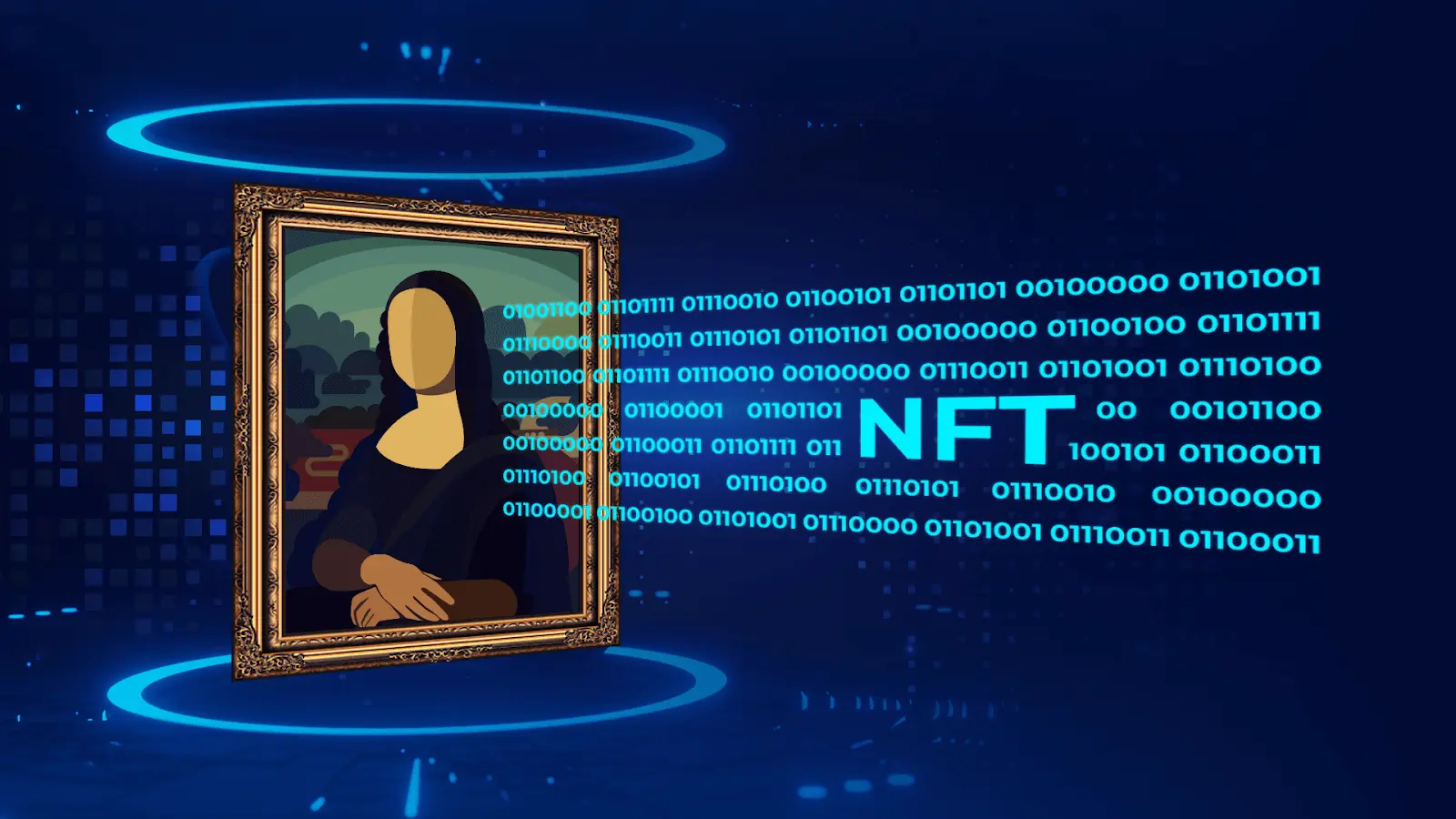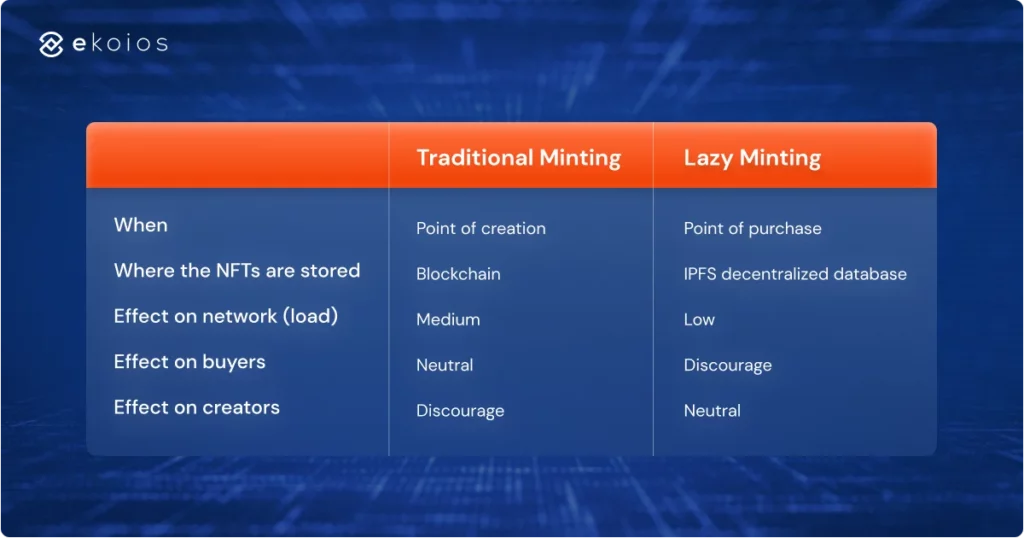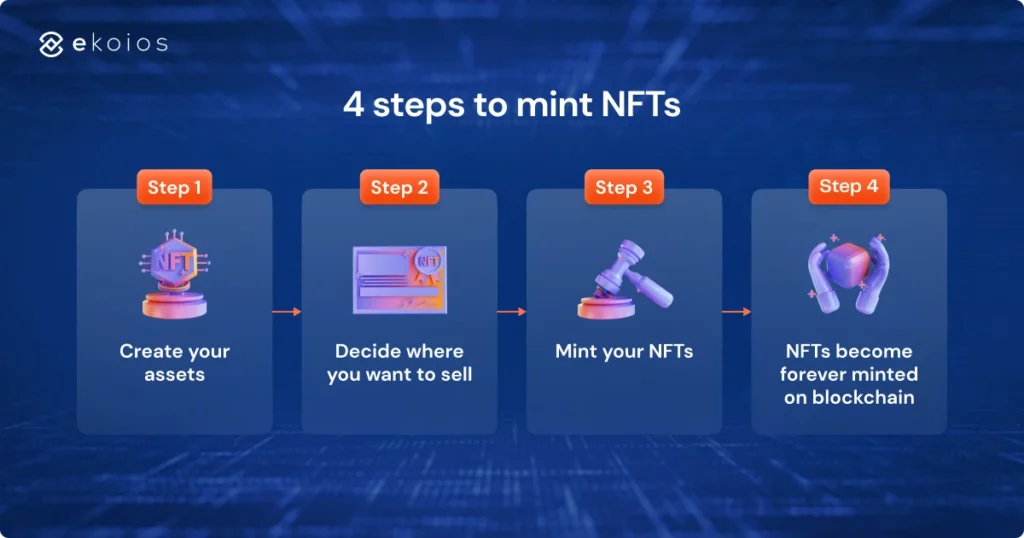
- 1
- 2
- 3
- 4
- 5
With all this hype around NFTs, you might be wondering whether it’s worth it to dip your toes into the NFT space and see what it is all about. The fact that you’re already here shows that you’re on the right track because, in this article, we’ll get through the whole minting process together – from learning about what it is, how you can mint, and where you can best NFT minting.
Let’s get started.
What Is NFT Minting?
NFT Minting is quite simply the act of tokenizing a digital asset on the blockchain – forever. It’s how you make any asset into a one-of-a-kind NFT.
Without diving deep into the technicalities, the minting process follows these simple steps
- Creating a smart contract: when an NFT is minted, you’re essentially writing smart contracts (self-executing contracts) onto the blockchain
- Paying gas fee: to write a new smart contact onto the blockchain, you need to pay gas fees (transaction fees) as a kind of operational cost
- Sell NFTs: your NFTs are sold at the end of the minting process
Despite the largely similar minting process, currently white label NFT marketplaces and minting systems employ different minting processes. namely traditional minting and lazy minting – both of which differ by the time of minting.
1. Traditional NFT minting
With traditional minting, an NFT is minted at the point of creation and thus helps to eliminate gas fees for buyers. In this way, buyers have more incentive to buy as they won’t be discouraged by the potential gas fees that come with each NFT creation.
However, for NFT creators who want to get into the NFT space, this could mean another entry barrier that they have to overcome as there’s not always a guarantee that their minted NFTs can be sold. In the big picture, this means that the way that traditional minting worked could potentially lead to a supply and demand problem – there are not enough people creating NFTs to drive mass NFT adoption.
2. Lazy NFT minting – Free NFT Minting for Creators
Faced with the limitations that come with traditional minting, lazy minting is a new minting method that’s been gaining popularity lately. When an NFT is lazy-minted, the NFT is minted at the point of purchase and not at the point of creation, and unlike traditional minting where the NFT creators are the ones who pay for the gas fee, with lazy minting, it’s the buyer who has to pay the gas fee – and therein lies the problem.
With buyers now being the primary ones to pay the gas fee (since there are cases when sellers have to pay instead – e.g., accepting a buying offer from buyers), lazy minting comes with some benefits that are too good to pass up for NFT creators:
- Low entry barriers: creating NFTs in a lazy minting system means that it’s free NFT minting, and creators could feel encouraged to create NFTs
- Reduce network congestion: since an NFT is only minted at the point of purchase, this means fewer network activities, and potentially no more network congestion
With all that said, it can be hard to differentiate between these two, so here’s a comparison table to help you understand the two minting methods better:

📌 Read the case study: The powerful NFT Minting System for Starry Trainee project
Where can you mint NFTs – NFT minting platform?
If you’re just getting started in the NFT space, you’ll want to create your NFTs in either an aggregated NFT marketplace (such as Opensea or Rarible), or use a minting system – and fortunately, both options already have the underlying logic of minting NFTs worked out for you.
1. Aggregated NFT Marketplaces
An aggregated NFT marketplace, as its name suggests, is an NFT marketplace with a concentrated number of NFT creators. Currently, an aggregated NFT marketplace offers the best way for new NFT creators to start selling their NFTs immediately thanks to the increased exposure and visibility that comes with the sheer size of the marketplace, but it does come with its own limitations as well which are lack of branding & scalability.
Pros:
- Increased exposure and visibility
Cons:
- Lots of competition
- Lack of scalability & branding
Cost:
- Free to start
- Has transaction fee
📌 Check out: Key features of a white lable NFT marketplace
2. Your Own NFT Minting Website
Alternatively, for bigger brands who want a more permanent solution, developing one’s own minting system is a more scalable solution in the long term. To develop your own minting system, you would have to rely on solution providers to take care of the job for you, but the end result should be a minting system that is able to scale your NFT project into the future well better than any aggregated NFT marketplace can.
Pros:
- Capable of minting thousands of NFTs at once
- You can bring your smart contracts to multiple popular NFT marketplaces
- You decide your own royalties
Cons:
- Not as convenient as creating NFTs right on aggregated NFT marketplaces
Costs
- Can be costly to choose a good minting system
Factors to consider when choosing where to mint your NFT
There’s not a one-size-fits-all solution for all business needs, so there are various factors to consider when choosing a platform to mint your NFTs:
Your minting goals
If you’re just getting started in the NFT space, chances are you would want to test the water first by creating a small NFT profile – it could be a small shop on aggregated NFT marketplaces such as Opensea, or your own branded NFT marketplace, created by white-label NFT platforms such as NFTify.
In this way, even if you didn’t manage to sell any NFT, there’s no investment loss, and at least you gained some experience by trying it out.
But for bigger NFT projects, it’s a different story. You might want to consider launching your own fully-functional NFT minting system that you can have total control over because the limitations that come with aggregated NFT marketplaces can affect you in the long run. If you’re going down this route, consider looking into solution providers who can develop for you a white label NFT minting platform.
Your budget – gas fee?
Budget plays an important role here when you’re considering where to mint NFTs. For most projects, going with free-to-start platforms such as Opensea or NFTify should be more than sufficient for their needs.
But for NFT projects that need more than what these platforms offer, consider looking into white-label solution providers such as Ekotek Technology. White-label solution providers will be able to develop for you a more tailored NFT minting system that fits your needs the best, but in exchange for this service, the solution can require a certain amount of investment.
How to Mint an NFT?
Since most of the popular NFT marketplaces and minting systems nowadays support lazy minting, the minting process for your NFTs has become rather affordable. To mint an NFT, all you need to do is to list your NFT for sale on your store/marketplace, and the minting process – the process of tokenizing the digital asset on the blockchain – is done when a buyer purchases the NFT.
 If you’re just getting started with minting NFTs, here’s the ideal approach:
If you’re just getting started with minting NFTs, here’s the ideal approach:
• Step 1: Create your assets
The first–and most crucial step– is to decide what your NFTs are going to be, which means creating the assets that are to be used for the creation of your NFTs. By default, NFTs are only the unique tokens that live on the blockchain, and it’s down to you to create unique, captivating NFTs.
• Step 2: Decide where you want to sell
When you have decided on what your NFTs will be, it’s time to decide where you want to sell it. Ideally, you’ll want to sell your NFTs where your target audience is at – and this means aggregated NFT marketplaces where you can publish your NFTs to a mas mass audience.
However, it’s important to note that some NFT marketplaces do not support importing existing smart contracts so it’s also important to look into this beforehand.
• Step 3: Mint your NFTs
After you’ve decided on where you want to sell your NFTs, it’s time to mint them. You might want to look into what kind of minting method your NFT marketplace or your minting system use because chances are, they might not support lazy minting, and you might have to pay a gas fee when listing your NFTs.
Additionally, in this step, it’s crucial to look into the NFT marketplaces and minting systems that you’re minting from and see what their policies have to offer. With current NFT marketplaces, for example, you can be earning less-than-ideal revenues from your secondary sales since you’re not in total control of setting your royalties.
• Step 4: The NFTs become forever minted on the blockchain
After you have created your NFTs (traditional minting) or after a buyer has purchased your NFT (lazy minting,) the NFT becomes forever minted on the blockchain. From this point, you can get to earn royalties from secondary sales of your NFTs.
Conclusion
And that concludes everything you need to know about minting NFTs. With all this newfound knowledge, we hope that you can now feel more confident venturing into the NFT space and start minting your first NFTs.
And in case you want to start your own minting website where you can have total control over your royalties and your NFTs, we have your back. Read more about how to develop your own minting system today, and see case studies of how well others are doing with Ekotek’ white-label minting systems and white-label NFT marketplaces.
FAQs
1. How long does it take to mint an NFT?
The actual process of uploading and minting your NFT shouldn’t take more than ten minutes maximum.
2. How much does it cost to mint an NFT?
This depends on the marketplace you’re using. But you can mint for as low as $4 or even cheaper on Polygon.
3. Can you mint an NFT for free?
So far, the only way to mint an NFT for free is by using the Moralis Rarible plugin in your NFT contract.
4. How do I mint an NFT collection?
To mint an NFT, you need to upload your files and pay for the gas fees to list them on the marketplace.
5. What happens after I’ve sold my NFT?
The NFT will be in the wallet of the buyer and you stand a chance of receiving royalties as it changes hands.
- 1
- 2
- 3
- 4
- 5